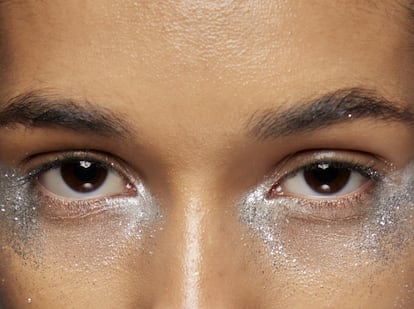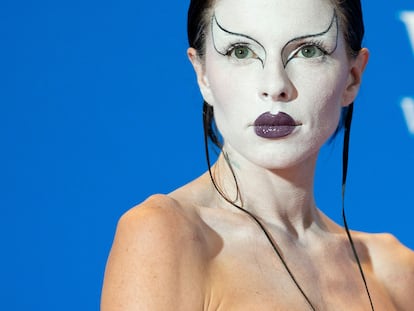The impact of the EU’s glitter makeup ban
The European Commission regulation that bans the decorative sparkles, in order to reduce polluting microplastics, has gone into effect

“The purpose is not to ban all glitter but replace plastic glitter with more environmentally friendly glitter that does not pollute our oceans.” That’s how the European Commission justifies the end of glitter sales as we’ve known them until now. The EU Regulation 2023/2066, titled “Restriction of microplastics intentionally added to products,” was approved on September 25 and went into effect on October 17 to restrict “synthetic polymer microparticles on their own or intentionally added to mixtures.” The measure doesn’t mean that sparkles will be gone forever. The ban only applies to “non-biodegradable, insoluble plastic. ”Biodegradable, soluble, natural or inorganic glitter is not considered microplastics and can continue being sold.”
As of today, there is a ban on loose glitter and microbeads as part of the restriction on #microplastics in products.
— European Chemicals Agency - ECHA 🇪🇺 (@EU_ECHA) October 17, 2023
For other uses, such as cosmetics and detergents, the ban applies later.
The restriction, developed by #ECHA, reduces microplastic pollution by 500 000 tonnes.
For now, decorative and craft glitter, and glitter included in toys and textiles, can no longer be sold. It must be substituted for biodegradable alternatives without microplastics. In the cosmetics industry, researchers have been looking for sparkles without contaminating particles for a while now. “There has been a lot of progress in the glitter field, and today we can have those qualities in biodegradable products,” said Diane Kendal from Rabanne in a recent interview with EL PAÍS’ beauty and fashion supplement. Some cosmetic products that include traditional glitter have a moratorium on their sale, what the European Commission calls the “transitional period,” in a section that specifies that “loose plastic glitter used as a cosmetic product, as well as cosmetics containing glitter (or other microplastics) are granted specific transitional periods under paragraph 6 and can continue being sold until, 16 October 2027 included, for rinse-off cosmetics; 16 October 2029 included, for leave-on cosmetics; 16 October 2035 included, for make-up, lip, and nail cosmetics.” The Commission emphasized that, in any case, “from 17 October 2031 until 16 October 2035, in order to continue to be sold, make-up, lip, and nail products need to bear a label indicating they contain microplastics.”
After presenting this regulation to restrict microplastics last September, the Commission explained that it was an urgent measure, given that “an estimated 42,000 tonnes of microplastics intentionally added to products are released in the EU each year.” These particles often contaminate the seas and oceans (Greenpeace estimates that between 21% and 54% of all microplastic particles in the world are found in the Mediterranean basin) and even end up in food. “The new rules will prevent the release of approximately half a million tonnes of microplastics into the environment,” the Commission said in September. Avoiding the presence of these synthetic elements in food is one of the organization’s priorities: “Once in the environment, microplastics do not biodegrade and cannot be eliminated. They accumulate in animals, including fish and shellfish, and, therefore, humans also consume them through food (…) Their continuous release contributes to the permanent contamination of our ecosystems and food chains.”
Most of the glitter that has been marketed to date is created with a combination of aluminum and polyethylene terephthalate (PET), a material resistant to biodegradation. As explained by Today Glitter, a bioglitter company born in Miami, the product was invented the American rancher and machinist Henry Ruschmann, who in 1934 designed a machine that combined a paper shredder and a wood shredder to grind plastic into glitter. With the beginning of the end of the sale of plastic glitter marked by the European Commission, “a 70% reduction in microplastic emissions is expected, which in the next 20 years would be equivalent to avoiding the emission into the environment of approximately half a million tons of these products,” the Garrigues law firm explains on its website.
Sign up for our weekly newsletter to get more English-language news coverage from EL PAÍS USA Edition
Tu suscripción se está usando en otro dispositivo
¿Quieres añadir otro usuario a tu suscripción?
Si continúas leyendo en este dispositivo, no se podrá leer en el otro.
FlechaTu suscripción se está usando en otro dispositivo y solo puedes acceder a EL PAÍS desde un dispositivo a la vez.
Si quieres compartir tu cuenta, cambia tu suscripción a la modalidad Premium, así podrás añadir otro usuario. Cada uno accederá con su propia cuenta de email, lo que os permitirá personalizar vuestra experiencia en EL PAÍS.
¿Tienes una suscripción de empresa? Accede aquí para contratar más cuentas.
En el caso de no saber quién está usando tu cuenta, te recomendamos cambiar tu contraseña aquí.
Si decides continuar compartiendo tu cuenta, este mensaje se mostrará en tu dispositivo y en el de la otra persona que está usando tu cuenta de forma indefinida, afectando a tu experiencia de lectura. Puedes consultar aquí los términos y condiciones de la suscripción digital.
More information
Últimas noticias
Most viewed
- Reinhard Genzel, Nobel laureate in physics: ‘One-minute videos will never give you the truth’
- Oona Chaplin: ‘I told James Cameron that I was living in a treehouse and starting a permaculture project with a friend’
- Pablo Escobar’s hippos: A serious environmental problem, 40 years on
- Charles Dubouloz, mountaineering star, retires at 36 with a farewell tour inspired by Walter Bonatti
- Why we lost the habit of sleeping in two segments and how that changed our sense of time










































